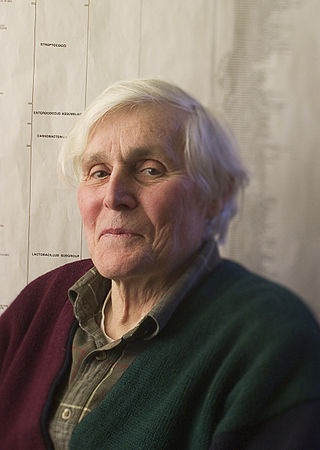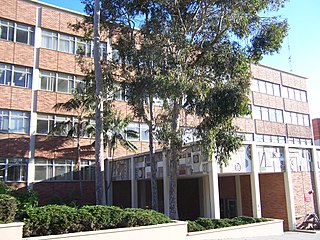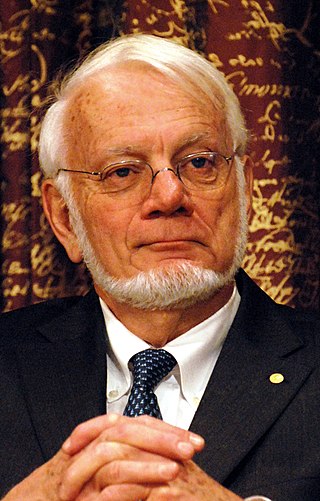Related Research Articles

The University of California, San Francisco (UCSF) is a public land-grant research university in San Francisco, California. It is part of the University of California system and is dedicated entirely to health science and life science. It conducts research and teaching in medical and biological sciences.

Carl Woese was an American microbiologist and biophysicist. Woese is famous for defining the Archaea in 1977 through a pioneering phylogenetic taxonomy of 16S ribosomal RNA, a technique that has revolutionized microbiology. He also originated the RNA world hypothesis in 1967, although not by that name. Woese held the Stanley O. Ikenberry Chair and was professor of microbiology at the University of Illinois Urbana–Champaign.
Nicole King is an American biologist and faculty member at the University of California, Berkeley in molecular and cell biology and integrative biology. She was awarded a MacArthur Fellowship in 2005. She has been an investigator with the Howard Hughes Medical Institute (HHMI) since 2013.
Herman Spieth was an American zoologist and university administrator. He was the first chancellor of the University of California, Riverside from 1956 to 1964. Originally hired as a professor in the Life Sciences Department, he was responsible for administering UCR's change from a liberal arts college to a major research university. Spieth Hall at UCR is named after him.

The UCLA College of Letters and Science is the arts and sciences college of the University of California, Los Angeles (UCLA). It encompasses the Life and Physical Sciences, Humanities, Social Sciences, Honors Program and other programs for both undergraduate and graduate students. It is often called UCLA College or the College, which is not ambiguous because the College is the only educational unit at UCLA to be currently denominated as a "college." All other educational units at UCLA are currently labeled as schools or institutes.
Gerald Mayer Rubin is an American biologist, notable for pioneering the use of transposable P elements in genetics, and for leading the public project to sequence the Drosophila melanogaster genome. Related to his genomics work, Rubin's lab is notable for development of genetic and genomics tools and studies of signal transduction and gene regulation. Rubin also serves as a vice president of the Howard Hughes Medical Institute and executive director of the Janelia Research Campus.
Theodore Garland Jr. is a biologist specializing in evolutionary physiology at the University of California, Riverside.

Thomas Arthur Steitz was an American biochemist, a Sterling Professor of Molecular Biophysics and Biochemistry at Yale University, and investigator at the Howard Hughes Medical Institute, best known for his pioneering work on the ribosome.
Richard O. Prum is an evolutionary biologist and ornithologist. He is the William Robertson Coe Professor of Ornithology, Ecology and Evolutionary Biology at Yale University, as well as the head curator of vertebrate zoology at the university's Peabody Museum of Natural History. His 2017 book The Evolution of Beauty: How Darwin’s Forgotten Theory of Mate Choice Shapes the Animal World—and Us was named one of the 10 Best Books of 2017 by The New York Times and was a finalist for the 2018 Pulitzer Prize in General Nonfiction.
Claire Kremen is an American conservation biologist. She is a professor of conservation biology at the University of British Columbia, having formerly worked at the University of California, Berkeley, where she remains professor emerita.
Mimi A. R. Koehl is an American marine biologist, biomechanist, and professor at University of California, Berkeley, and head of the Koehl Lab. She was a MacArthur Fellow in 1990.
Nancy A. Moran is an American evolutionary biologist and entomologist, University of Texas Leslie Surginer Endowed Professor, and co-founder of the Yale Microbial Diversity Institute. Since 2005, she has been a member of the United States National Academy of Sciences. Her seminal research has focused on the pea aphid, Acyrthosiphon pisum and its bacterial symbionts including Buchnera (bacterium). In 2013, she returned to the University of Texas at Austin, where she continues to conduct research on bacterial symbionts in aphids, bees, and other insect species. She has also expanded the scale of her research to bacterial evolution as a whole. She believes that a good understanding of genetic drift and random chance could prevent misunderstandings surrounding evolution. Her current research goal focuses on complexity in life-histories and symbiosis between hosts and microbes, including the microbiota of insects.

Grace Evelyn Pickford was an American biologist and endocrinologist, known for "devising ingenious instruments and techniques" and her work on the hematology and endocrinology of fishes.
Pamela Soltis is an American botanist. She is a distinguished professor at the University of Florida, curator at the Florida Museum of Natural History, principal investigator of the Laboratory of Molecular Systematics and Evolutionary Genetics at the Florida Museum of Natural History, and founding director of the University of Florida Biodiversity Institute.
Xuemei Chen is a Chinese-American molecular biologist. She is the Furuta Chair Professor in the Department of Botany and Plant Sciences at the University of California, Riverside. She was elected to the US National Academy of Sciences in 2013.

Rosemary Gillespie is an evolutionary biologist and professor of Environmental Science, Policy & Management, Division of Insect Biology at the University of California, Berkeley. She was the President of the American Genetics Association in 2018 and was previously President of the International Biogeography Society 2013–2015. From 2011 to 2013 she had served at the president of the American Arachnological Society. As of 2020 she is the faculty director of the Essig Museum of Entomology and a Professor and Schlinger Chair in systematic entomology at the University of California, Berkeley. Gillespie is known for her work on the evolution of communities on hotspot archipelagoes.

David P. Mindell is an American evolutionary biologist and author. He is currently a senior researcher at the University of California, Berkeley, Museum of Vertebrate Zoology. Mindell's work is focused on the systematics, conservation and molecular evolution of birds, especially birds of prey. He is known for his 2006 book, The Evolving World in which he explained, for the general public, how evolution applies to everyday life.
References
- 1 2 3 "Staff Profiles: Cheryl Y. Hayashi". American Museum of Natural History. American Museum of Natural History. Retrieved 16 February 2024.
- 1 2 3 4 "Cheryl Hayashi". Biology UC Riverside. University of California Riverside. Retrieved 24 March 2017.
- 1 2 3 "Cheryl Hayashi: Spider Silk Biologist". MacArthur Fellows. MacArthur Foundation. 28 January 2007. Retrieved 24 March 2017.
- ↑ Meserole, Rachel (26 February 2009). "Alumnus Profile: Cheryl Hayashi SM '88: "From Science Hill to Spider Silk Studies"". Yale Scientific. Yale University. Retrieved 24 March 2017.
- ↑ "Unraveling the wonders of spider silk". National Science Foundation Discoveries. National Science Foundation. 9 December 2008. Retrieved 24 March 2017.
- ↑ Hayashi, Cheryl (1996). Molecular systematics of spiders: Evidence from ribosomal DNA (Thesis 9635417 ed.). Yale University. pp. 414 pages.
- ↑ "TED2010: Speakers A-Z". conferences.ted.com. Archived from the original on 2011-07-13. Retrieved 2010-03-27.
- ↑ "Discovery: Roundup of TED2010, Session 2". ted.com. 11 February 2010.